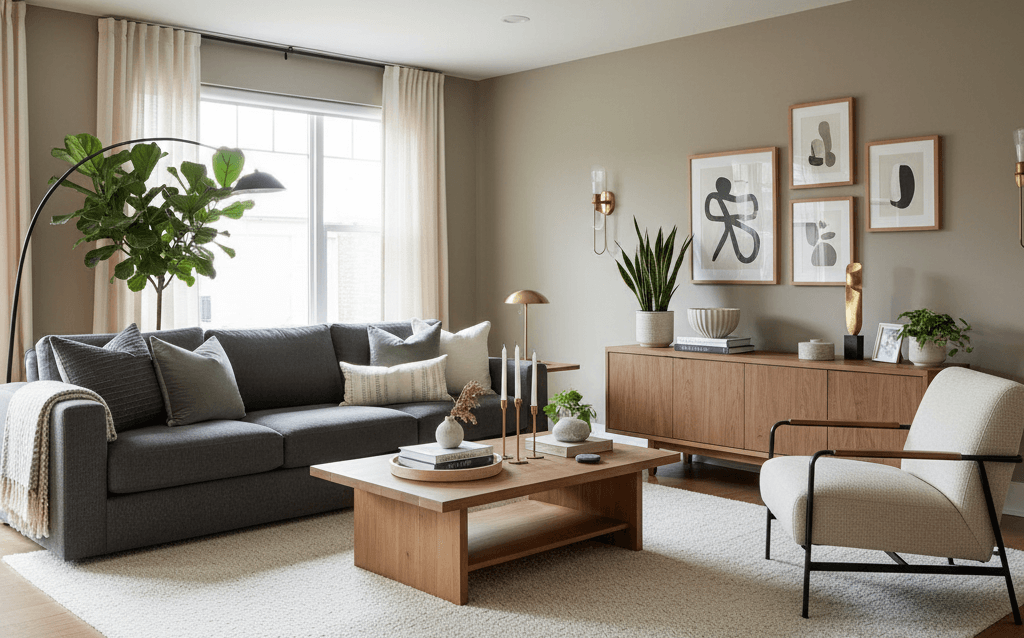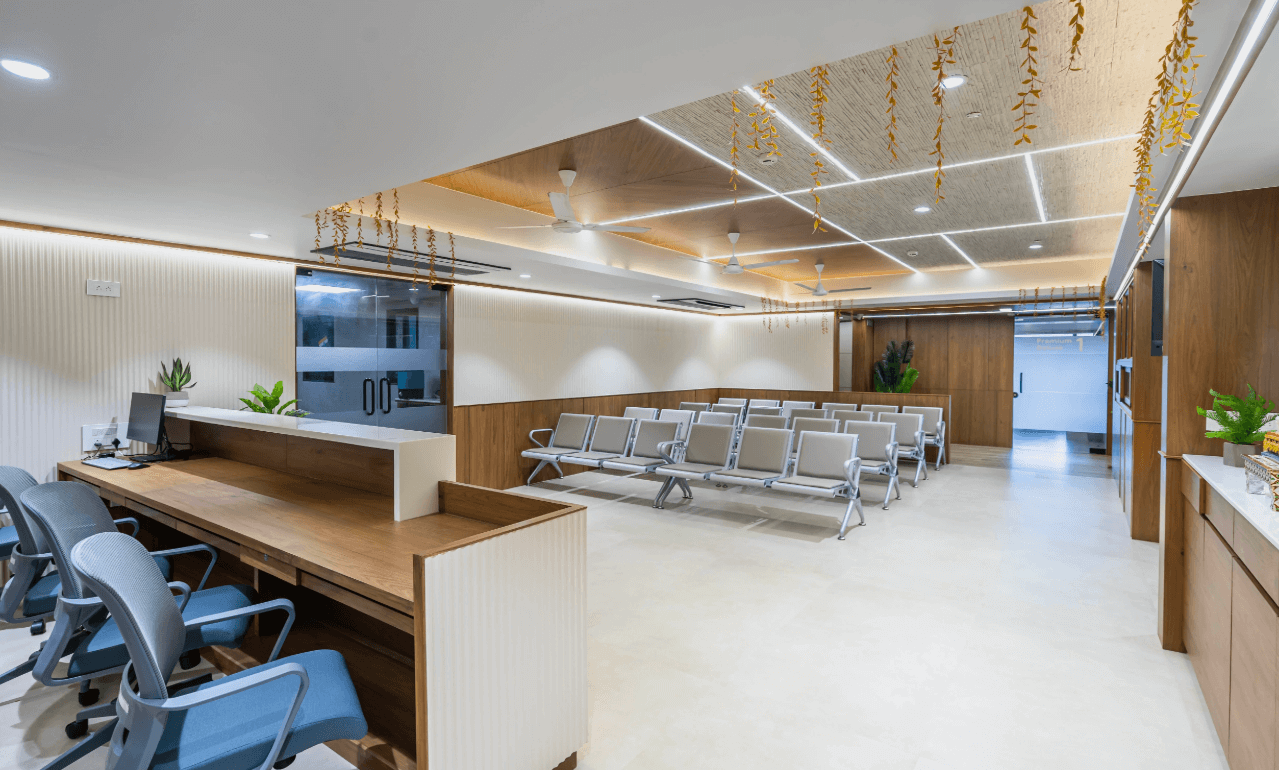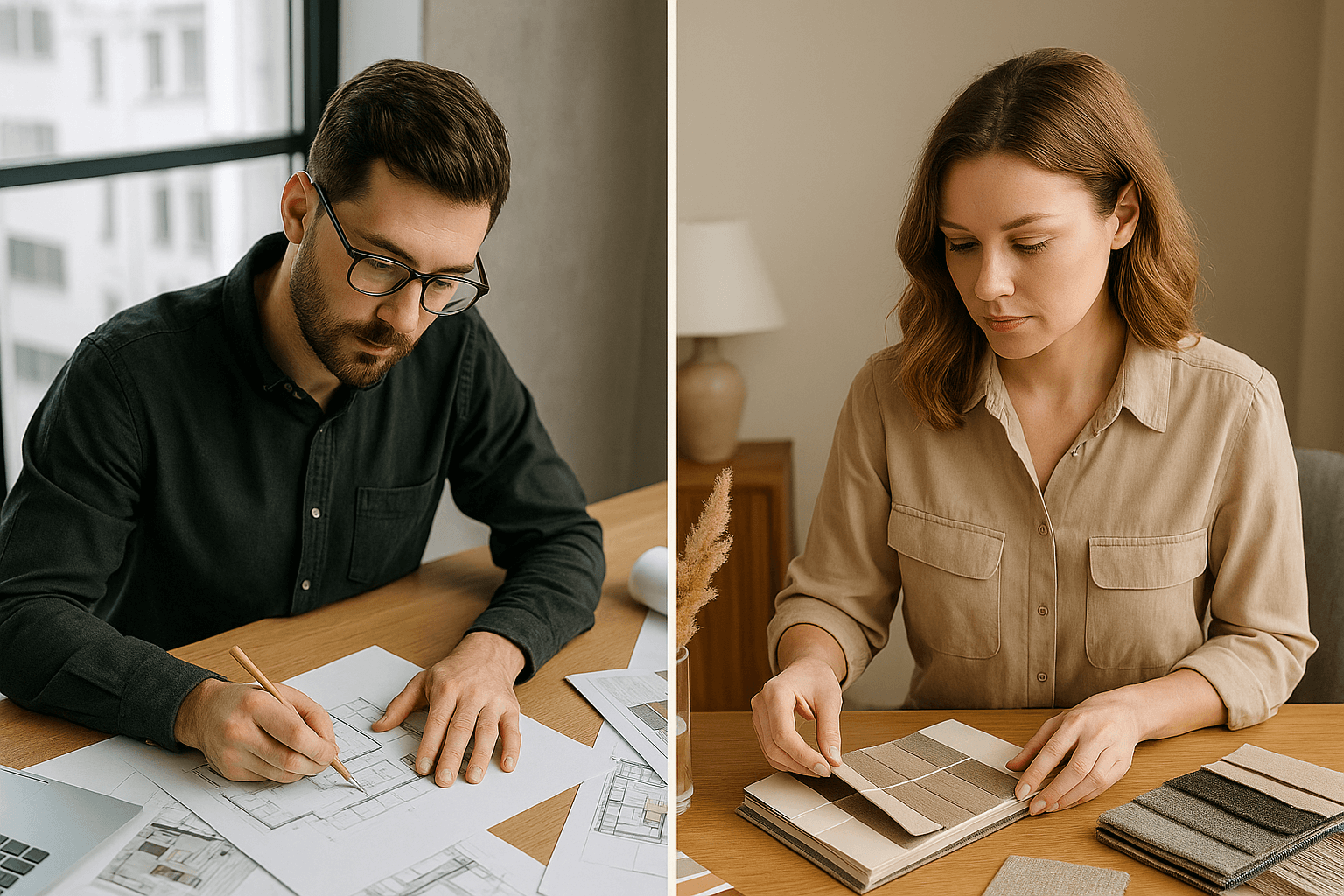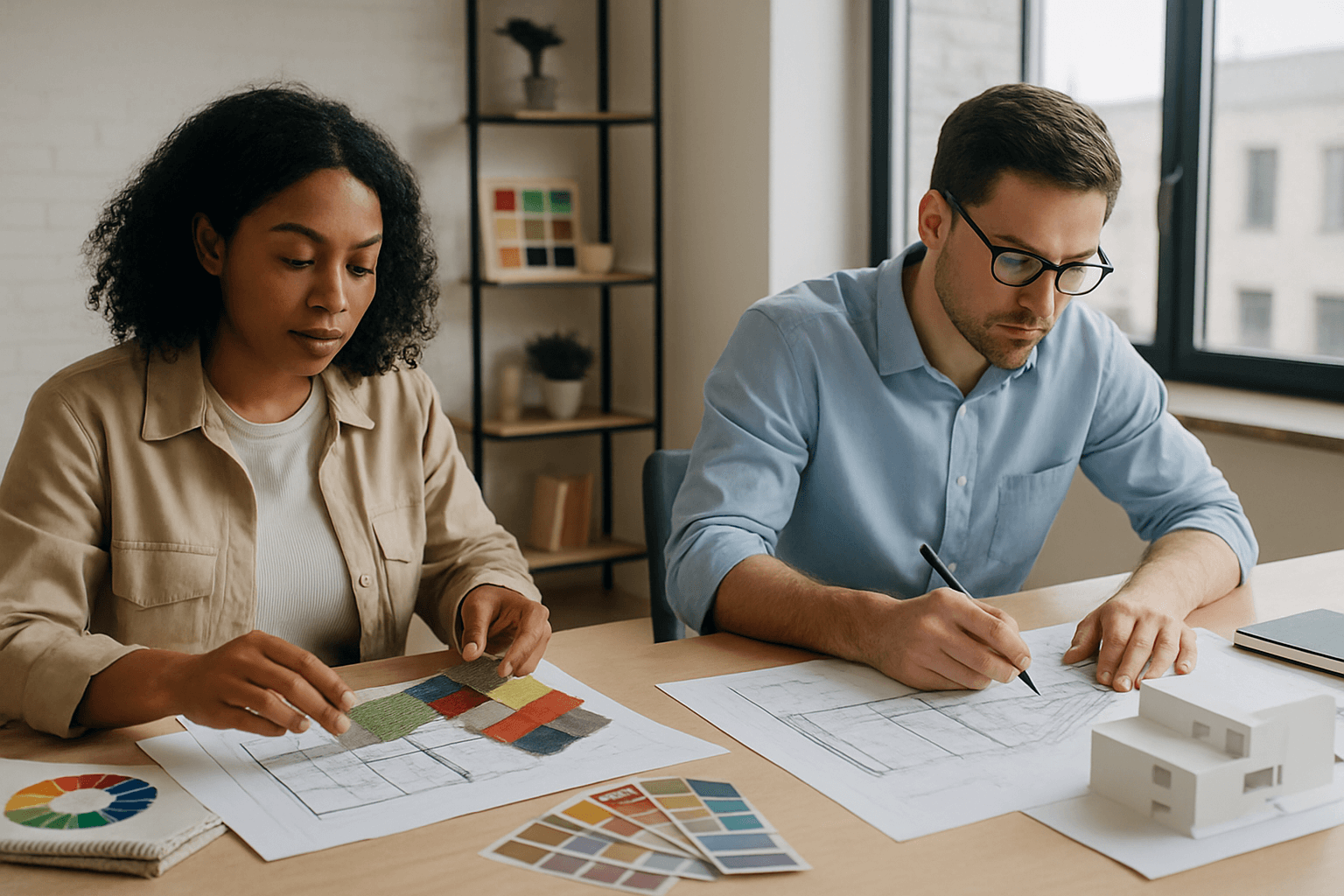A well-designed advocate office interior is more than just furniture and decor — it’s a reflection of professionalism, trust, and clarity. In Ahmedabad, where corporate and legal sectors are growing rapidly, advocate office interior design has become essential for creating an environment that inspires confidence in clients and supports focused work for lawyers.
Modern law firm interior designs blend functionality with aesthetics — offering well-planned chambers, confidential meeting zones, and neatly organized filing areas. Whether it’s a small advocate chamber, a corporate law firm, or a personal office for legal professionals, the right design layout helps improve efficiency, comfort, and brand image.
At Ahmedabad Interior Designer, we specialize in creating professional and functional advocate office interiors that combine modern design, soundproof planning, and practical storage solutions. Our designs ensure a perfect balance between sophistication and functionality — helping you make a strong first impression while maintaining a focused work atmosphere.
If you’re planning to set up or renovate your advocate office in Ahmedabad, this guide covers everything — from layout ideas and cost estimates to Vastu tips and expert design recommendations to help you build a space that truly represents your profession.
Why Advocate Office Interior Design Matters?
The design of an advocate’s office plays a vital role in creating a sense of trust, professionalism, and efficiency. A well-planned advocate office interior not only sets the tone for client interactions but also enhances the advocate’s productivity and focus.
1. Builds Client Trust and Professionalism
A thoughtfully designed office immediately conveys credibility. Neutral color palettes, clean furniture lines, and elegant décor reflect confidence and reliability — key to winning client trust.
2. Improves Functionality and Workflow
Smart law office interior layouts ensure smooth movement and organization. Dedicated spaces for meetings, research, and client consultations help advocates stay focused and efficient.
3. Ensures Confidentiality and Privacy
Soundproofing solutions and private chambers are essential to maintain confidentiality. Acoustic panels, solid partitions, and strategic seating arrangements ensure discussions remain private.
4. Enhances Comfort and Productivity
Proper lighting, ergonomic furniture, and clutter-free storage solutions contribute to focus and comfort during long hours. Balanced lighting — both natural and artificial — supports a stress-free work environment.
5. Reflects Brand Identity and Personality
Every advocate has a distinct style — from classic and traditional to sleek and modern. Your advocate office interior design in Ahmedabad should mirror your professional ethos, helping clients connect with your brand.
Key Elements of a Modern Advocate Office Design
A well-designed advocate office interior combines functionality, comfort, and sophistication. From the reception area to private chambers, every element should reflect professionalism and ensure smooth day-to-day operations. Here’s a breakdown of the most important design elements that define a modern law firm office interior in Ahmedabad or anywhere in India.
1. Reception Area: Creating the Right First Impression
The reception area is the first point of contact for clients, so it should convey trust and professionalism. A well-designed advocate office reception features clean lines, a neutral color palette, and a clutter-free layout. Comfortable seating, subtle lighting, and a minimal backdrop with your law firm’s logo create a lasting impression of credibility and class.
Pro Tip: Use soft lighting and indoor plants to make the space feel warm yet formal.
2. Workstations & Advocate Chambers: Organized and Private
An advocate’s chamber should be designed for focus, confidentiality, and comfort. Each lawyer workstation must provide ergonomic seating, optimal desk height, and storage for case files. Privacy partitions or frosted glass walls ensure that each chamber remains quiet and confidential while maintaining a sense of openness.
Key Consideration: Invest in noise-cancelling design elements and functional furniture that supports long working hours.
3. Client Meeting Room / Conference Area: Designed for Discussions
Client meetings are central to every advocate’s practice. The conference area should be spacious, soundproof, and equipped with comfortable seating. A modern law office meeting room design includes sleek conference tables, warm lighting, and presentation equipment for professional discussions.
Tip: Use acoustic wall panels or carpeting to reduce echo and maintain confidentiality.
4. Library & Filing Area: Organized and Accessible
For advocates, well-organized documentation is crucial. A library and filing section should feature smart shelving, labeled drawers, and digital document storage zones. Modern law office interiors often blend traditional bookcases with modular cabinets to maximize space and enhance accessibility.
Suggestion: Integrate compact, vertical storage units to utilize height efficiently.
5. Lighting & Color Scheme: Balanced and Professional
Lighting plays a vital role in shaping the office’s ambiance. Neutral wall colors like beige, grey, or off-white paired with natural lighting create a calm and focused environment. Layered lighting — a mix of ambient, task, and accent lighting — enhances both functionality and aesthetics.
Tip: For a professional yet warm look, many advocate office designs in Ahmedabad use diffused LED lighting and matte finishes that prevent glare.
6. Furniture Design: Elegant, Functional, and Durable
Office furniture should strike the perfect balance between comfort and authority. Opt for high-quality wooden desks, ergonomic leather chairs, and well-crafted cabinetry. In modern advocate office interior design, furniture is designed to offer storage efficiency while maintaining a refined, minimal appearance.
Pro Tip: Use matching tones for furniture and flooring to create a cohesive and polished look.
Each of these elements contributes to creating a functional, confidential, and client-friendly workspace. Whether it’s a solo chamber or a large law firm office, the right interior design enhances both your brand image and your productivity.
Design Styles for Advocate Offices
Every law office reflects the personality and practice style of the advocate. From classic chambers that exude power to modern spaces that highlight efficiency, your advocate office interior design plays a vital role in creating the right professional impression. Here are some of the most popular advocate office design styles in India, each offering a unique blend of aesthetics, comfort, and functionality.
1. Traditional Chamber Design:
A traditional advocate office interior design exudes authority, professionalism, and timeless sophistication. This classic style is preferred by senior lawyers and advocates who wish to create an impression of credibility and trust the moment clients walk in. A traditional lawyer’s chamber design typically combines dark wood finishes, vintage décor, and rich textures that reflect years of experience and confidence.
A well-designed classic advocate office interior doesn’t just look elegant—it enhances focus, creates a calm environment for consultations, and reinforces the advocate’s professional image. The overall setup helps clients feel they are in safe and experienced hands, which is especially vital in the legal profession.
Key Design Features:
- Premium wooden furniture and finishes: Use high-quality wood for desks, bookshelves, and paneled walls to give a vintage yet durable appeal.
- Warm, dim lighting: Choose layered lighting—such as wall sconces or table lamps—to create a formal and composed atmosphere.
- Law-themed décor elements: Add framed law degrees, case studies, old legal manuscripts, or symbolic scales of justice to reinforce your professional identity.
- Comfortable seating and layout: Plush leather chairs and well-arranged chambers enhance both comfort and client experience.
Ideal For:
This style is perfect for senior advocates, legal consultants, and law firms who prefer a formal and prestigious setup that communicates wisdom, stability, and trustworthiness.
A traditional advocate chamber design stands out as a symbol of authority—ideal for professionals who value legacy, structure, and timeless elegance in their workspace.
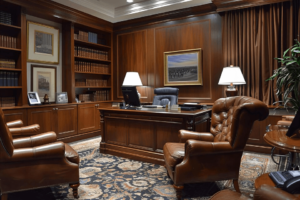
2. Modern Advocate Office Interior Design:
A modern advocate office interior design prioritizes efficiency, functionality, and contemporary aesthetics. Unlike traditional chambers, this lawyer office design integrates technology, open layouts, and smart storage solutions to create a professional yet innovative workspace. The goal is to provide a setting that enhances productivity, improves collaboration, and reflects a progressive legal practice.
Key Features of a Modern Advocate Office:
- Minimalist and ergonomic furniture: Sleek desks, ergonomic chairs, and clutter-free surfaces create a clean and functional workspace while maintaining a professional appeal.
- Glass partitions and open layouts: Frosted or clear glass walls enhance natural lighting, improve transparency, and encourage communication within teams.
- Integrated technology solutions: Smart lighting systems, digital case management tools, and multimedia setups ensure efficiency and modern workflow.
- Optimized storage and organization: Modular cabinets and concealed storage units help keep documents and legal files organized, maintaining a polished environment.
Ideal For:
This design is perfect for young advocates, corporate law firms, and legal professionals who value modern aesthetics, functionality, and innovative office interiors. It balances form and function, supporting fast-paced legal practices while leaving a strong impression on clients.
A modern lawyer office interior is not just visually appealing—it creates a productive, professional, and collaborative environment, making it an excellent choice for contemporary law offices in Ahmedabad and across India.
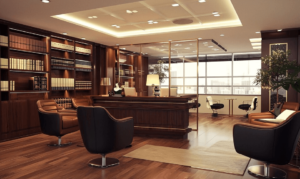
3. Shared Office Spaces:
Shared office spaces for lawyers and co-working setups are gaining popularity among small law firms, start-ups, and legal teams in Ahmedabad and across India. These designs combine professionalism with collaboration, enabling multiple advocates to work efficiently while optimizing costs. A well-planned shared office ensures privacy, smooth workflow, and a professional environment for client interactions.
Key Features of Shared Advocate Office Interiors:
- Collaborative workstations: Modular desks or shared work areas encourage teamwork, seamless communication, and easy coordination between associates.
- Private cabins and meeting rooms: Soundproof cabins and dedicated conference spaces maintain confidentiality during sensitive client meetings.
- Efficient storage solutions: Smart filing cabinets, digital document management, and organized storage systems ensure legal documents are easily accessible and secure.
- Flexible layout and scalability: The office can be easily adjusted to accommodate growing teams, making it ideal for expanding law practices.
Ideal For:
Start-up law firms, partnerships, or independent advocates who want a professional office without heavy investment. This setup offers a cost-effective, functional, and collaborative workspace while maintaining a polished and client-ready appearance.
A shared advocate office interior design balances teamwork and privacy, helping legal professionals maximize productivity, reduce overhead costs, and maintain a professional brand image.
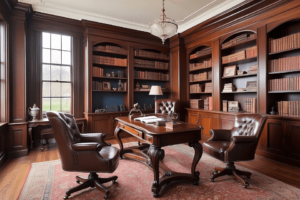
4. Home-Based Advocate Office:
With the rise of remote legal work and flexible working arrangements, home-based advocate office interiors have become increasingly popular among independent lawyers and consultants. A well-designed home office allows advocates to maintain professionalism, confidentiality, and efficiency while enjoying the comfort of working from home.
Key Features of a Home Lawyer Office Design:
- Dedicated workspace: A separate, organized area ensures minimal distractions, soundproofing for confidential client discussions, and optimal workflow.
- Professional technology setup: High-quality video conferencing equipment, fast internet, and digital document management systems enable seamless virtual client meetings and online hearings.
- Functional and aesthetic design: Neutral wall colors, layered lighting, minimal décor, and ergonomic furniture create a calm and focused environment.
- Smart storage solutions: Cabinets, shelves, and secure filing systems help maintain order, ensuring easy access to case files while preserving client confidentiality.
Ideal For:
Solo practitioners, independent consultants, and advocates working remotely who require a professional yet personal space. This home-based lawyer office design ensures a balance between comfort, efficiency, and privacy, making it suitable for formal client interactions and productive daily work.
A thoughtfully planned home advocate office interior reflects the lawyer’s professional image while offering the convenience of working from home without compromising on privacy or style.

5. Hybrid Advocate Office Interior Design:
A hybrid advocate office interior design merges the classic charm of traditional law chambers with the functionality and innovation of modern office interiors. This approach is ideal for advocates and law firms in Ahmedabad and across India who want a workspace that reflects professional heritage while supporting today’s fast-paced legal practice.
Key Features of a Hybrid Lawyer Office Design:
- Furniture and Storage: Timeless wooden desks, cabinets, and bookshelves paired with modular storage systems optimize space and functionality.
- Color Palette and Textures: Neutral walls with warm accents, rich textures, and subtle décor create a sophisticated yet welcoming environment.
- Modern Technology Integration: Smart lighting, automated systems, and tech-friendly workstations ensure efficiency and streamlined legal operations.
- Flexible Workspaces: Areas designed for private client meetings, collaborative teamwork, and solo work maintain a balance of privacy and productivity.
Ideal For:
Established advocates, boutique law firms, and senior legal professionals who want to combine heritage-inspired office aesthetics with modern conveniences.
A hybrid advocate office interior offers the best of both worlds—timeless elegance, practical functionality, and technological efficiency—making it perfect for professionals who value tradition, style, and performance.

Cost of Advocate Office Interior Design in Ahmedabad
Designing a professional advocate office requires balancing aesthetics, functionality, and budget. The cost of advocate office interior design in Ahmedabad typically ranges from ₹1,200 to ₹2,500 per sq. ft., depending on the quality of materials, finishes, and level of customization.
Cost Breakdown by Component:
- Furniture: Elegant desks, ergonomic chairs, client seating, and storage cabinets can account for 30–40% of the budget. Opting for modular furniture can reduce costs without compromising quality.
- Partitions and Workstations: Glass or frosted partitions, privacy panels, and modular workstations typically make up 20–25% of the investment, creating a functional and collaborative environment.
- Lighting & Ambiance: Proper lighting—both natural and artificial—is crucial for professional lawyer office interiors. Layered lighting, task lights, and ambient lighting can cost 10–15% of the total budget.
- Design Consultancy & Planning: Professional interior design advice, layout planning, and 3D visualizations usually contribute 10–15%, ensuring that the space is both practical and visually appealing.
Modular vs. Custom Office Interiors
- Modular Office Interiors: Cost-effective, quick to install, and flexible, modular setups are ideal for startups, small firms, or budget-conscious lawyers.
- Custom Office Interiors: Tailored designs with premium finishes, bespoke furniture, and unique layouts are perfect for senior advocates, high-profile firms, and boutique law offices.
Turnkey Interior Solutions
For advocates who want a complete hassle-free experience, turnkey office interiors include design, execution, furniture, and finishing, ensuring a ready-to-use professional office space that aligns with both brand image and functional needs.
Budget-Friendly Options
Even with a limited budget, functional and stylish lawyer office interiors in Ahmedabad can be achieved by prioritizing essential workstations, modular furniture, and smart storage solutions, without compromising professionalism or aesthetics.
| Component | Description | Approx. Cost Range (% of Budget) |
|---|---|---|
| Furniture | Desks, ergonomic chairs, client seating, storage cabinets; modular options available | 30–40% |
| Partitions & Workstations | Glass/frosted partitions, privacy panels, modular workstations for efficient workflow | 20–25% |
| Lighting & Ambiance | Layered lighting, task lights, ambient lighting, natural light optimization | 10–15% |
| Design Consultancy & Planning | Layout planning, 3D visualization, professional interior design advice | 10–15% |
| Turnkey Execution | Complete package including furniture, finishes, and setup for a ready-to-use office | Varies by customization |
| Budget-Friendly Solutions | Modular furniture, essential workstations, smart storage for small firms or startups | Lower cost option |
Why Hire a Professional Interior Designer for Advocate Offices in Ahmedabad?
Designing an advocate office requires more than just aesthetics—it involves functional planning, efficient use of space, and creating a professional environment that inspires trust and confidence in clients. Hiring a professional interior designer ensures that every aspect of your office, from layout to lighting, works in harmony to enhance workflow and professionalism.
Benefits of Professional Interior Design for Law Offices:
- Efficient Space Utilization: Experts optimize available space for workstations, client meeting areas, conference rooms, and filing systems, ensuring smooth movement and effective workflow.
- Professional Appeal: Interior designers select the right furniture, color schemes, lighting, and décor that reflect the advocate’s brand and create a welcoming, authoritative atmosphere.
- Timely Execution: With experience in law firm and office interiors in Ahmedabad, professionals manage timelines, coordinate with contractors, and deliver a turnkey office that meets your specifications.
- Customized Solutions: From modular workstations to traditional chambers, a professional designer can create a space tailored to your firm’s size, style, and budget.
- Long-Term Value: Well-planned interiors reduce maintenance costs, improve functionality, and enhance client perception, making your investment truly worthwhile.
Ahmedabad Interior Designer specializes in creating law firm interiors that combine efficiency, style, and professionalism. Our team understands the unique needs of advocates, ensuring that your office not only looks impressive but also functions seamlessly for daily operations.
Frequently Asked Questions (FAQs) About Advocate Office Interior Design in Ahmedabad
1. What is the average cost of advocate office interior design in Ahmedabad?
The cost of designing an advocate office in Ahmedabad typically ranges from ₹1,200 to ₹2,500 per sq. ft., depending on the choice of materials, furniture, partitions, and lighting. Modular layouts are more cost-effective, while custom designs and luxury finishes increase the investment.
2. How do I design a professional lawyer’s office?
A professional lawyer’s office should balance aesthetic appeal with functionality. Key considerations include a welcoming reception area, ergonomic workstations, soundproof client meeting rooms, proper lighting, and organized filing systems. Hiring an expert in law firm interior design in Ahmedabad ensures a polished and functional workspace.
3. Which wall colors are best for a lawyer’s chamber?
Neutral tones like beige, grey, and off-white are ideal for law office interiors as they convey professionalism and trust. Accent colors such as navy or muted green can enhance focus and sophistication. These interior wall color ideas for advocate offices also improve lighting and mood.
4. How much space is required for a law office setup?
For a small firm, an advocate office can function efficiently in 500–800 sq. ft., while larger offices or multiple partners may require 1,200 sq. ft. or more. Space planning experts recommend allocating dedicated areas for reception, workstations, client meetings, and filing.
5. What are the key elements of a modern advocate office interior?
Modern advocate office designs in Ahmedabad focus on ergonomic furniture, open layouts, glass partitions, smart lighting, and tech-integrated workstations. Combining functionality with aesthetics enhances productivity and client experience.
6. Who is the best office interior designer in Ahmedabad?
Top interior designers in Ahmedabad specialize in advocate office and law firm interiors, offering services from space planning, modular design, furniture selection, to turnkey solutions. Look for designers registered with COA for professional credibility.
7. Can I design a home-based advocate office?
Yes, a home office for advocates can be designed to maintain professionalism and confidentiality. Essential features include a dedicated workspace, soundproofing, proper lighting, ergonomic furniture, and secure digital and physical filing systems.
8. What are the popular design styles for law offices?
Advocate offices can be designed in traditional, modern, hybrid, or shared office styles. Traditional chambers emphasize wood and leather furniture, while modern designs focus on open layouts, glass partitions, and minimalistic décor. Hybrid designs combine both elements.
9. How can I reduce interior design costs for a law office?
Cost-effective strategies include using modular furniture, prioritizing key areas like reception and conference rooms, opting for durable yet affordable materials, and planning designs early during construction or renovation.
10. How long does it take to complete an advocate office interior in Ahmedabad?
The timeline depends on office size, customization, and finishes, typically ranging from 6–12 weeks for small to medium offices. Professional designers manage scheduling, sourcing, and installation to ensure timely project completion.

